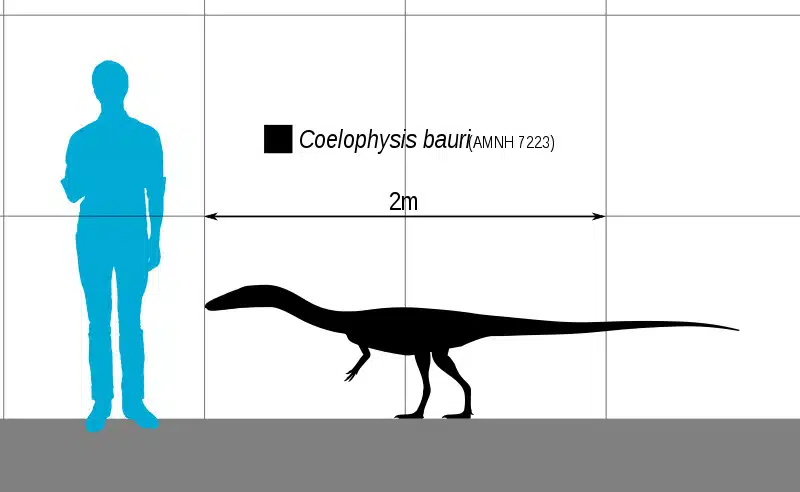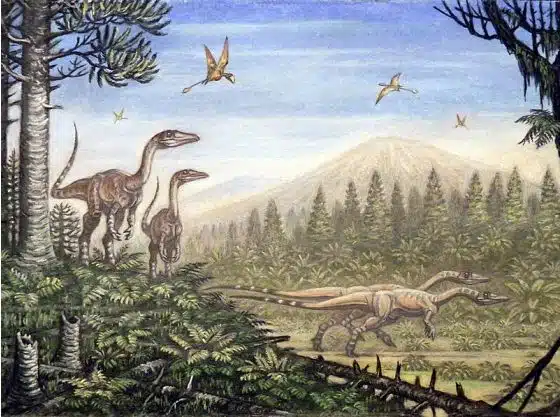Coelophysis, whose name means “hollow form,” roamed the earth during the Late Triassic period, meaning this was a really early dino. Its unique characteristics and adaptations provide a window into a time long past, offering insights into the evolution of dinosaurs and the world they inhabited.
Coelophysis, with its slender body and agile movements, was a creature of remarkable design. Its hollow bones were a feature that would later become common in birds and contributed to its lightweight structure, enabling it to move swiftly to catch its prey. This dinosaur, despite its seemingly delicate form, was a formidable predator and a testament to the intricate balance of strength and agility that nature often achieves.
Key facts
| Keyword | Fact |
|---|---|
| Coelophysis pronunciation | koh-lee-oh-fye-sis |
| Meaning of name | Hollow form |
| Group | Saurischia |
| Type Species | Coelophysis bauri |
| Diet | Carnivore |
| When it Lived | 221.5 to 199.3 MYA |
| Period & Time | Late Triassic |
| Epoch | Lacian to Hettangian |
| Length | 6 to 10 ft |
| Height | 3 ft |
| Weight | 35-45 lbs |
| Mobility | Moved on two legs |
| First Discovery | 1881 by Edward Drinker Cope |
| Location of first find | New Mexico, USA |
| First Described by | 1889 by Edward Drinker Cope |
| Holotype | AMNH 7223 |
Coelophysis Taxonomy and Timeline
The name of this dinosaur translates to “hollow form” and is derived from the Greek words ‘koilos’ meaning hollow and ‘physis’ meaning form. This aptly describes its unique skeletal structure, characterized by hollow bones.

Taxonomically, this dinosaur belongs to the Theropoda group. Within this group, it is classified under the family Coelophysidae. The species most commonly referred to when discussing this genus is the type species Coelophysis bauri, named in honor of the American paleontologist G. Baur.
The timeline of Coelophysis is rooted in the Late Triassic period, a time when the earth was undergoing significant changes. This period, part of the larger Mesozoic Era, was characterized by the diversification and dominance of dinosaurs. Due to its unique adaptations, this dinosaur thrived during this time and left behind a rich fossil record that continues to be studied by scientists.
Listen to Pronunciation
Discovery & Fossil Evidence
Coelophysis was first discovered in 1881 by Edward Drinker Cope–a renowned American paleontologist. The find took place in New Mexico, USA and marked a new milestone in the study of dinosaurs by shedding light on a creature that had previously been unknown. The holotype, designated as AMNH 7223, is housed at the American Museum of Natural History.

Since the initial discovery, numerous fossil finds have been made that expand our understanding of this fascinating dinosaur. Notably, Coelophysis fossil remains have also been found in regions outside of New Mexico, including Connecticut and Massachusetts. These finds indicate a wider geographical distribution than initially thought.
The fossils provide a wealth of information about its physical characteristics and lifestyle. The preservation of these fossils varies, with some showcasing intricate details of the dinosaur’s skeletal structure while others offer glimpses into its diet and behavior. Each fossil find adds a new piece to the puzzle and helps us to reconstruct the life of this ancient predator.
Coelophysis Size and Description
Despite its seemingly delicate form, this was a predator of remarkable design. Its physical characteristics, from its slender body to its agile movements, were perfectly suited to its lifestyle as a carnivorous dinosaur.
Short description of Coelophysis
This was a small theropod that was characterized by a slender body and a long, narrow neck. Its head was small and pointed, equipped with sharp teeth designed for catching and holding onto prey. The dinosaur’s vertebrae were hollow, contributing to its lightweight structure and enabling swift, agile movements. Its limbs were well-developed with the hind limbs adapted for bipedal locomotion. Coelophysis‘ tail was long and slender, likely serving as a counterbalance during movement.

Size and Weight of Type Species
Coelophysis was a relatively small dinosaur, much smaller than some of the giants that would come later. Its length has been estimated at between just over 6 feet, and possibly as long as 1o feet for a fully grown adult. Being much longer than it was tall, its height was around 3 feet. Having a fast and agile build, its weight is estimated at between 35 to 45 lbs.
These estimates, however, are based on the fossils that have been discovered so far and actual sizes may have varied. Despite its small size, Coelophysis was a formidable predator that relied on its speed and agility to catch its prey.
Coelophysis in Detail
With its hollow bones and agile movements, this was a creature of remarkable design. Its unique characteristics and adaptations provide a window into a time long past, offering insights into the evolution of dinosaurs and the world they inhabited.
One of the most distinctive features of Coelophysis is its hollow bones. This feature is also found in birds and contributed to the dinosaur’s lightweight structure, enabling it to move swiftly to catch its prey. The hollow bones of Coelophysis are a testament to the intricate balance of strength and agility that nature often achieves.
Coelophysis also had a unique feeding strategy. Unlike many other carnivorous dinosaurs, this dinosaur was not a picky eater. It is believed to have fed on a variety of small animals, including insects and small reptiles. Its overall build was long and slender, with a small head full of sharp teeth at the end of a long narrow neck. This adaptability in diet likely played a crucial role in the dinosaur’s survival, allowing it to thrive in a variety of environments and conditions.
Coelophysis in its Natural Habitat

This dinosaur thrived in a world vastly different from our own. The Late Triassic period, when this dinosaur roamed the earth, was a time of significant geological and climatic changes and the time when the supercontinent Pangaea had formed. The environment was characterized by a warm, dry climate, with vast deserts and sparse vegetation. Despite these harsh conditions, this Pangaean dinosaur managed to thrive, adapting to its surroundings in remarkable ways.
As a carnivore, Coelophysis fed on a variety of small animals such as insects and small reptiles. It’s sharp teeth and agile movements made it a skilled hunter capable of catching its prey with precision and speed. This carnivore, with its adaptability and hunting prowess, was a key player in the ecosystem of its time that influenced the distribution and evolution of other species.
As such, it had a significant impact on its environment despite its small size. Its hunting activities likely shaped the distribution of prey species and influenced the structure and dynamics of the ecosystem. Furthermore, with its social behavior and pack-hunting strategies, it may have played a role in shaping the social dynamics of other dinosaur species.
Interesting Points about Coelophysis
- This was one of the earliest dinosaurs to exhibit bird-like features such as hollow bones.
- Despite its small size, the Coelophysis was a formidable predator. Mainly relying on its speed and agility to catch its prey.
- It has a wide geographical distribution with fossils found in various regions across the United States.
- This carnivore was not a picky eater, feeding on a variety of small animals including insects and small reptiles.
Contemporary Dinosaurs
Coelophysis shared its world with a captivating array of contemporaries.
Consider Eucoelophysis, a dinosaur that was somewhat smaller in stature. This creature, while not as physically imposing as Coelophysis, still played a significant role in the ecosystem. It’s conceivable that these two species might have competed for similar resources despite their size difference, their paths crossing in a constant struggle for survival.
Then there was Postosuchus–a creature that was considerably larger and more formidable. This dinosaur had an imposing size and strength and could have been a potential predator to Coelophysis. The presence of such a powerful contemporary would have undoubtedly influenced the behavior and survival strategies of Coelophysis. Ading a clear element of danger to its daily existence.
Gojirasaurus and Daemonosaurus also shared this prehistoric landscape. Gojirasaurus, similar in size to Coelophysis, might have been a competitor or even a potential threat. Daemonosaurus, with its distinctively short snout and long teeth, likely occupied a different niche in the ecosystem.
Coelophysis used its keen agility and survival instincts to navigate a world filled with diverse contemporaries. Each interaction, each encounter, whether as competitor or prey, would have shaped its existence. It has left us with a vivid picture of life in this fascinating prehistoric era.
List of All Dinosaurs
We have created a list of all dinosaurs we have covered here, sorted across the seven main groups of dinosaurs. We also include information about their type of diet, (omnivore, herbivore or carnivore) and the time they lived.
Frequently Asked Questions
The name translates to “hollow form,” referring to the dinosaur’s unique skeletal structure characterized by hollow bones.
It lived during the Late Triassic period across North America on the supercontinent of Pangaea.
As a carnivore, it fed on a variety of small animals including insects and small reptiles.
Edward Drinker Cope, a renowned American paleontologist made the first discovery in 1881.
It is known for its hollow bones–a feature that is also found in birds. This contributed to the dinosaur’s lightweight structure and enabled swift, agile movements.
The fossils of the Coelophysis have been found in various regions across the United States. Including the first finds in New Mexico and subsequent finds in Connecticut and Massachusetts.
Sources
- https://d3qi0qp55mx5f5.cloudfront.net/paulsereno/i/galleries/Sereno_1998-PhyloDefs.pdf?mtime=1644417559
- https://www.researchgate.net/publication/322171215_A_New_Early_Coelophysoid_Neotheropod_from_the_Late_Triassic_of_Northwestern_Argentina
- https://www.researchgate.net/publication/316029275_A_Late_Norian-Rhaetian_Coelophysid_Neotheropod_Dinosauria_Saurischia_from_the_Quebrada_Del_Barro_Formation_Northwestern_Argentina
Article last fact checked:Joey Arboleda, 06-11-2023
Featured Image Credit: Michiel Petrified Forest from Petrified Forest, USA, Public domain, via Wikimedia Commons
